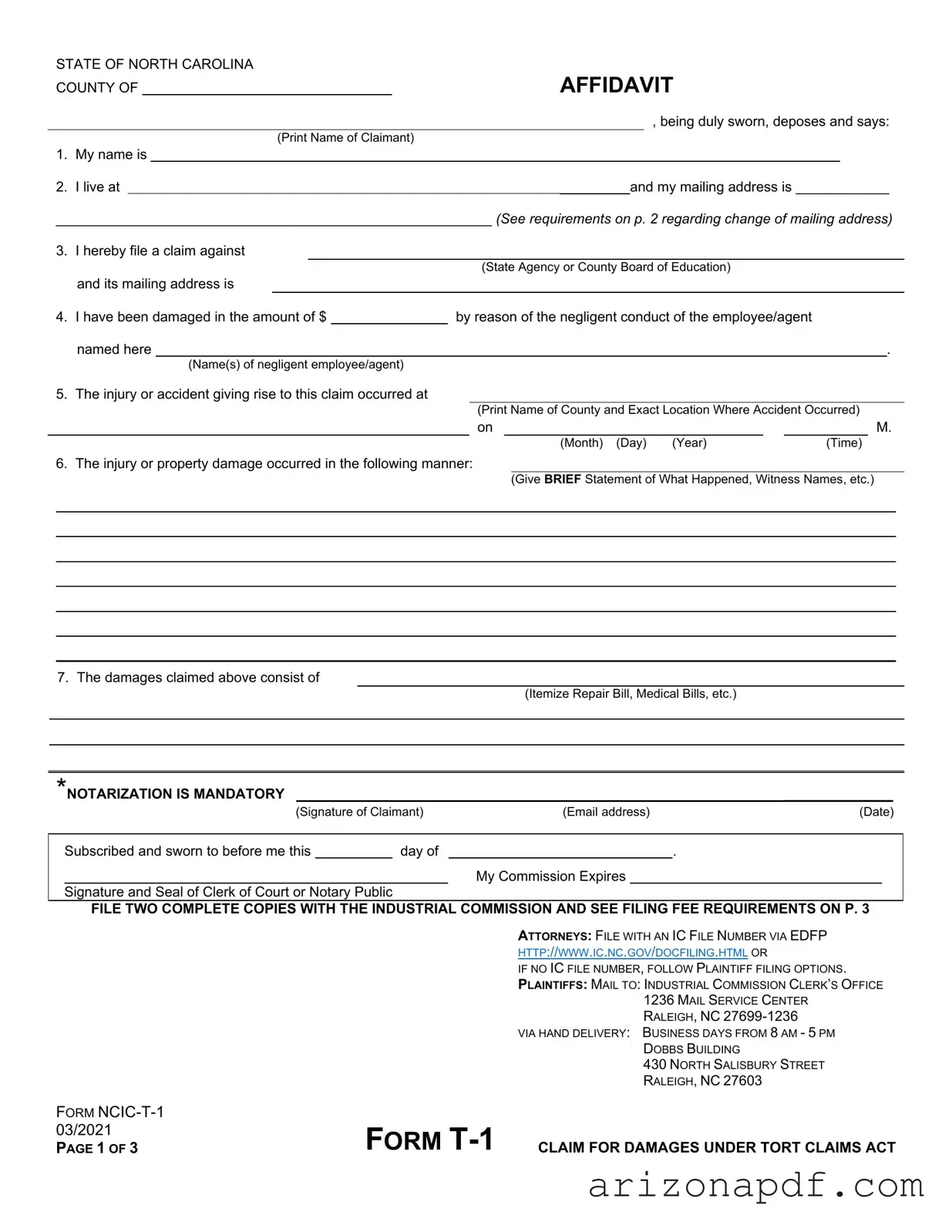STATE OF NORTH CAROLINA COUNTY OF
|
|
|
|
|
, being duly sworn, deposes and says: |
|
|
|
(Print Name of Claimant) |
1. |
My name is |
|
|
|
|
2. |
I live at |
|
_________and my mailing address is ____________ |
|
|
|
|
|
|
|
________________________________________________________ (See requirements on p. 2 regarding change of mailing address)
3. |
I hereby file a claim against |
|
|
|
|
|
|
|
|
|
|
|
|
|
|
|
|
|
|
|
|
|
(State Agency or County Board of Education) |
|
|
|
|
|
|
and its mailing address is |
|
|
|
|
|
|
|
|
|
|
|
|
|
4. |
I have been damaged in the amount of $ |
|
by reason of the negligent conduct of the employee/agent |
|
|
|
|
|
|
named here |
|
|
|
|
|
|
|
|
. |
|
|
|
|
(Name(s) of negligent employee/agent) |
|
|
|
|
|
|
|
|
|
|
|
|
5. |
The injury or accident giving rise to this claim occurred at |
|
|
|
|
|
|
|
|
|
|
|
|
|
|
|
|
|
|
|
|
|
(Print Name of County and Exact Location Where Accident Occurred) |
|
|
|
|
|
|
|
|
|
on |
|
|
|
|
|
M. |
|
|
|
|
|
|
|
|
|
|
|
(Month) (Day) |
(Year) |
(Time) |
6. |
The injury or property damage occurred in the following manner: |
|
|
|
|
|
|
|
|
|
|
|
|
|
|
|
|
|
|
(Give BRIEF Statement of What Happened, Witness Names, etc.) |
|
|
|
|
|
|
|
|
|
|
|
|
|
|
|
|
|
|
|
|
|
|
|
|
|
|
|
|
|
|
|
|
|
|
|
|
|
|
|
|
|
|
|
|
|
|
|
|
|
|
|
|
|
|
|
|
|
|
|
|
|
|
|
|
|
|
|
|
|
|
|
|
|
|
|
|
|
|
|
|
|
|
|
|
|
|
|
|
|
|
|
|
|
|
|
|
|
|
|
|
|
|
|
|
|
|
|
|
|
|
|
|
|
|
|
|
|
|
|
|
|
|
|
|
|
|
|
|
|
|
|
|
|
7. The damages claimed above consist of
(Itemize Repair Bill, Medical Bills, etc.)
*NOTARIZATION IS MANDATORY |
|
|
|
|
______________ |
|
(Signature of Claimant) |
(Email address) |
(Date) |
|
|
|
|
|
|
Subscribed and sworn to before me this |
|
day of |
|
. |
|
My Commission Expires
Signature and Seal of Clerk of Court or Notary Public
FILE TWO COMPLETE COPIES WITH THE INDUSTRIAL COMMISSION AND SEE FILING FEE REQUIREMENTS ON P. 3
|
|
ATTORNEYS: FILE WITH AN IC FILE NUMBER VIA EDFP |
|
|
HTTP://WWW.IC.NC.GOV/DOCFILING.HTML OR |
|
|
IF NO IC FILE NUMBER, FOLLOW PLAINTIFF FILING OPTIONS. |
|
|
PLAINTIFFS: MAIL TO: INDUSTRIAL COMMISSION CLERK’S OFFICE |
|
|
1236 MAIL SERVICE CENTER |
|
|
RALEIGH, NC 27699-1236 |
|
|
VIA HAND DELIVERY: BUSINESS DAYS FROM 8 AM - 5 PM |
|
|
DOBBS BUILDING |
|
|
430 NORTH SALISBURY STREET |
|
|
RALEIGH, NC 27603 |
FORM NCIC-T-1 |
|
|
03/2021 |
FORM T-1 |
|
PAGE 1 OF 3 |
CLAIM FOR DAMAGES UNDER TORT CLAIMS ACT |
INSTRUCTIONS
The North Carolina Tort Claims Act requires that every affidavit submitted must show ALL of the following:
1.The name of the claimant.
2.The name of the state department, institution or agency against which the claim is filed.
3.The name of the state employee upon whose alleged negligence the claim is based.
4.The amount of damages sought to be recovered.
5.The time and place where the injury occurred.
6.A brief statement of the facts and circumstances surrounding the injury.
7.If the claim involves a school bus, the claim should be filed against the particular COUNTY Board of Education concerned and NOT against the State Board of Education.
8.A claim for property damage to a motor vehicle must be in the NAME OF THE REGISTERED OWNER OF THE
VEHICLE ONLY.
INDUSTRIAL COMMISSION REQUIREMENTS REGARDING CONTACT INFORMATION (INCLUDING CHANGE OF MAILING ADDRESS) ARE SET OUT IN THE RULE APPEARING BELOW:
11 NCAC 23B .0105 CONTACT INFORMATION
(a)"Contact information" for purposes of this Rule shall include telephone number, facsimile number, email address, and mailing address.
(b)All persons or entities without legal representation who have matters pending before the Commission shall inform the Commission of any change in contact information by filing a written notice via the Commission's Electronic Document Filing Portal ("EDFP"), email to contactinfo@ic.nc.gov, facsimile to (919) 715-0282, U.S. mail sent to Office of the Clerk, 1236 Mail Service Center, Raleigh North Carolina 27699-1236, private courier service in accordance with Rule .0101 of this Section, or hand delivery in accordance with Rule .0101 of this Section.
(c)A plaintiff without legal representation who was an inmate in the North Carolina Division of Adult Corrections at the
time of filing his or her tort claim, shall, within 30 days of release, provide the Commission with written notice of his or her post-release contact information in any manner authorized in Paragraph (b) of this Rule. Following the initial written notice of post-release contact information, the previously incarcerated plaintiff shall continue to inform the Commission of all changes in contact information in accordance with Paragraph (b) of this Rule.
(d)All attorneys of record with matters before the Commission shall provide and maintain current contact information for the Commission's records via EDFP.
(e)Instructions on how to provide and update contact information via EDFP are available at https://www.ic.nc.gov/docfiling.html.
FORM NCIC-T-1 |
|
|
03/2021 |
FORM T-1 |
|
PAGE 2 OF 3 |
CLAIM FOR DAMAGES UNDER TORT CLAIMS ACT |
INDUSTRIAL COMMISSION REQUIREMENTS REGARDING FILING FEES ARE SET OUT IN THE RULE APPEARING BELOW:
11 NCAC 23B .0103 FILING FEES
(a)No tort claim shall be accepted for filing with the Commission unless the claim is accompanied by an attorney's check, certified check, money order, or electronic transfer of funds in payment of a filing fee in an amount equal to the filing fee required for the filing of a civil action in the Superior Court division of the General Court of Justice.
(b)The provisions of Paragraph (a) of this Rule notwithstanding, a tort claim that is accompanied by a Petition to Sue as an Indigent shall be accepted for filing upon the date of its receipt.
(c)A Petition to Sue as an Indigent shall consist of an affidavit sufficient to satisfy the provisions of G.S. 1-110, stating that plaintiff is unable to comply with Paragraph (a) of this Rule.
(d)If the Commission determines the plaintiff is able to pay the fee assessed under this Rule, an Order shall be issued directing payment of that fee, and the plaintiff shall, within 30 days from receipt of the Order, forward to the Commission an attorney's check, certified check, money order, or electronic transfer of funds for the full amount required to be paid. Failure to submit the required amount of the filing fee within this time shall result in the tort claim being dismissed without prejudice.
(e)Upon consideration of a prison inmate's Petition to Sue as an Indigent, the Commission shall determine whether the inmate's tort claim is frivolous and whether to dismiss the claim, pursuant to G.S. 1-110. Appeals from the dismissal of a frivolous tort claim pursuant to G.S. 1-110 shall proceed directly to the Full Commission and shall be decided without oral argument.
FORM NCIC-T-1 |
|
|
03/2021 |
FORM T-1 |
|
PAGE 3 OF 3 |
CLAIM FOR DAMAGES UNDER TORT CLAIMS ACT |

